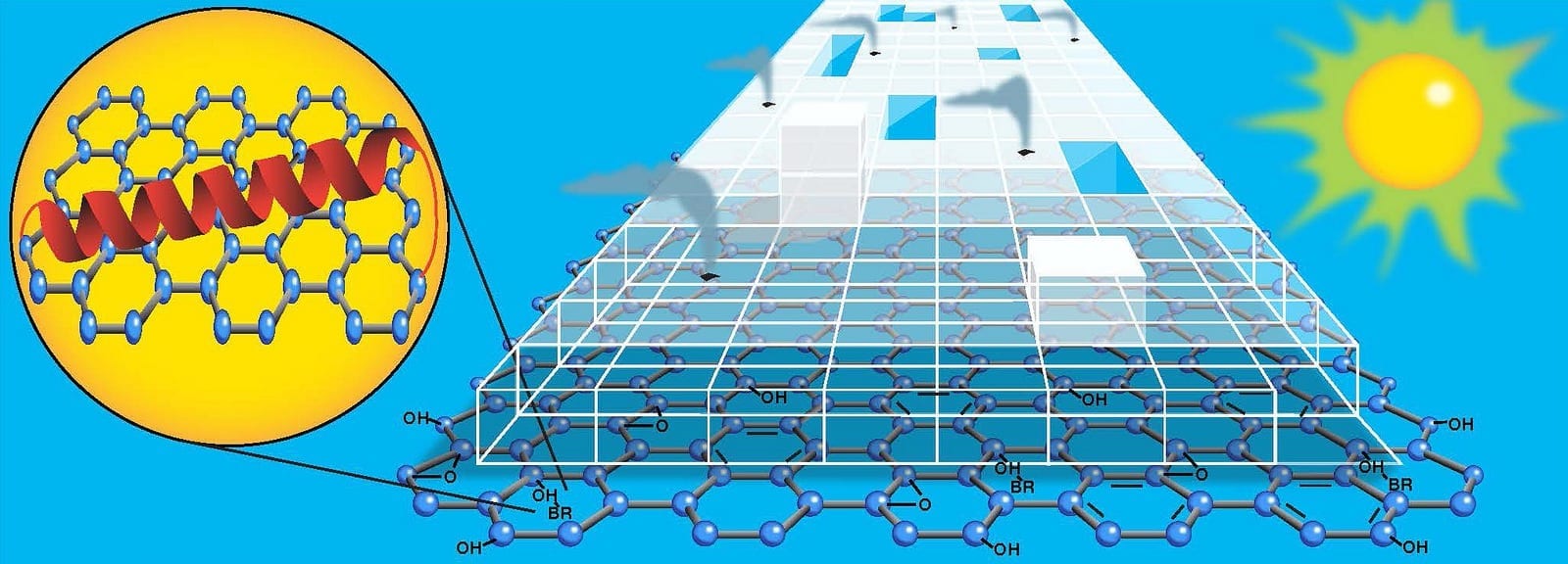
Her team’s discovery may provide future consumers a biologically-inspired alternative to gasoline.
Researchers at the US Department of Energy’s (DOE) Argonne National Laboratory have created a small scale “hydrogen generator” that uses light and a two-dimensional graphene platform to boost production of the hard-to-make element.
The research also unveiled a previously unknown property of graphene. The two-dimensional chain of carbon atoms not only gives and receives electrons, but can also transfer them into another substance.
Hydrogen is virtually everywhere on the planet, but the element is typically bonded with other elements and must be separated from oxygen in H2O to produce free hydrogen. The commercial separation process uses natural gas to react with superheated steam to strip away hydrogen atoms producing hydrogen fuel, but also carbon dioxide —a greenhouse gas byproduct which escapes into the atmosphere.
Argonne’s early-stage generator, composed of many tiny assemblies, is proof that hydrogen can be produced without burning fossil fuels. The scale is small, a little smaller than the diameter of spider silk. Scaling this research up in the future may mean that you could replace the gas in your cars and generators with hydrogen—a greener option, because burning hydrogen fuel emits only water vapor.
“Many researchers are looking to inorganic materials for new sources of energy,” said Elena Rozhkova, chemist at Argonne’s Center for Nanoscale Materials, a DOE Office of Science (Office of Basic Energy Sciences) User Facility. “Our goal is to learn from the natural world and use its materials as building blocks for innovation.”
The Latest on: Hydrogen generator
[google_news title=”” keyword=”Hydrogen generator” num_posts=”10″ blurb_length=”0″ show_thumb=”left”]
via Google News
The Latest on: Hydrogen generator
- Toyota Establishes North American Hydrogen HQon May 1, 2024 at 7:24 am
Reaffirming its commitment to support fuel cell and additional hydrogen-related products and technology toward a hydrogen economy, Toyota Motor North ...
- Toyota “hydrogen headquarters” will develop US fuel-cell productson May 1, 2024 at 4:00 am
The California hydrogen fuel-cell facility will span from R&D to sales and will reach well beyond Toyota's lineup of cars and trucks.
- Toyota Establishes Hydrogen Headquarters to Accelerate Advancement of Fuel Cell Technologyon May 1, 2024 at 4:00 am
Reaffirming its commitment to support fuel cell and additional hydrogen-related products and technology toward a hydrogen economy, Toyota Motor North America (TMNA) today announced that it is renaming ...
- Decarbonizing the Power Industry with Low-Carbon-Intensity Hydrogenon May 1, 2024 at 3:01 am
hydrogen supply options will allow high throughput trials and a packaged hydrogen generator or pipeline service option will allow permanent hydrogen adoption long-term. In the power industry’s future ...
- This New Development Shows Toyota’s Unwavering Commitment Towards Hydrogen Fuel Cell Technologyon April 30, 2024 at 5:00 pm
fuel cell generator, a 325-kW solid oxide fuel cell (SOFC), and an onsite 500-kWh battery energy storage system. Toyota is hoping for it to be ready and operational by 2026. Toyota has been at the ...
- Hyliion and BayoTech partner to provide sustainable power with hydrogen hubs and the Karno generatoron April 30, 2024 at 5:10 am
The companies have entered into an agreement to support the advancement of sustainable power generation using hydrogen.
- Hyliion and Victory Execute Letter of Intent to Deploy up to 10 KARNO™ Generators to H2 Energy Groupon April 29, 2024 at 2:16 pm
Hyliion Holdings Corp. (NYSE: HYLN) (“Hyliion”), a developer of sustainable electricity-producing technology, Victory Clean Energy Inc. (OTC : VYEY) ( ...
- 'Critical to have sufficient back-up capacity': Singapore to boost power reliability with 2 new generators, says EMAon April 29, 2024 at 1:21 am
Singapore's power supply is set to receive a boost with two new generators, according to a press release by the Energy Market Authority (EMA) on Monday (April 29). These new 100MW Fast Start ...
- Hyliion and BayoTech Partner to Provide Sustainable Power with Hydrogen Hubs and the KARNO™ Generatoron April 25, 2024 at 5:30 am
Hyliion Holdings Corp. (NYSE: HYLN) ("Hyliion"), a developer of sustainable electricity-producing technology, and BayoTech, an innovator in hydrogen production, transportation and storage solutions, ...
- Earth Day 2024: Engineer Uses Hydrogen To Save The Internal Combustion Engineon April 22, 2024 at 12:09 pm
To save the Earth and make it a better place for his grandson when he's ready to drive, former GM engineer Mike Copeland has found a way to use hydrogen in old cars.
via Bing News











